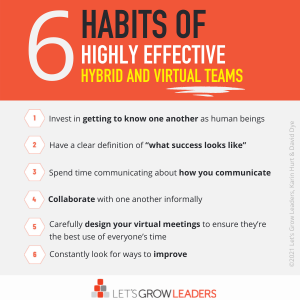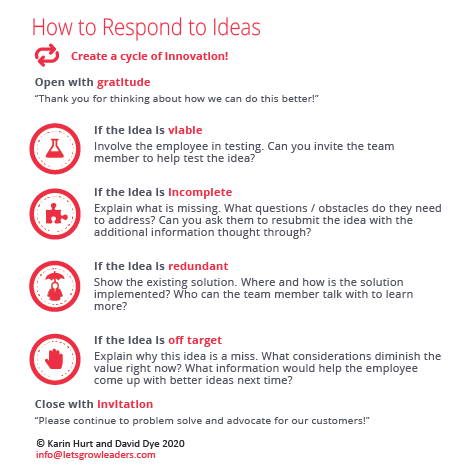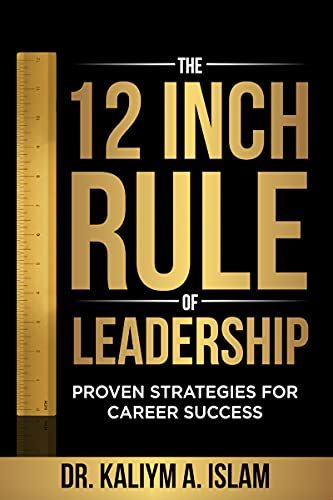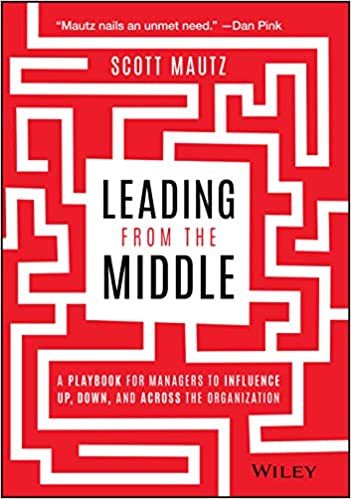David Dye's Blog, page 62
July 23, 2021
The 12 Inch Rule of Leadership with Dr. Kaliym Islam
In this wisdom-packed interview, former Wallstreet executive Dr. Kaliym Islam shares the many leadership moments that transformed his career. This is practical, research-based, (and hard-won) leadership wisdom that will help you have more influence, achieve better results with your teams, and achieve the career recognition you desire. There are no shortcuts to leadership success, but the principles Dr. Kaliym shares from the 12 Inch Rule of Leadership will truly help you to be the leader you want your boss to be.
The 12 Inch Rule of Leadership2:00 – Introducing Kaliym Islam, PhD, author of The 12 Inch Rule of Leadership
6:00 – Discover the roots of Kaliym’s approach to leadership through his experience in a historically black fraternal organization.
7:15 – The discovery that people who internalized the 12 Inch Rule were succeeding in a variety of careers, industries, and leadership.
8:10 – How Kaliym studied the successes he saw and brought his PhD research chops to bear on what he observed.
10:02 – How leaders help their teams internalize the messages that matter most.
10:50 – An incredibly vital business question you can use in every discussion with your team.
12:13 – How confidence and humility work together to power your leadership and influence
13:49 – Then we discuss how Kaliym learned this leadership humility
17:16 – Next, we dive into a specific look at several of the key behaviors and principles beneath them.
18:12 – First, we look at the Virtue of Patience and how it informs executive presence and a leader’s influence.
23:02 – A practical example of how to receive feedback and respond with regard – even when it’s hard to hear.
27:15 – Next, we look at the 12 Inch Rule of Leadership principle of Talent Expression – speaking up and sharing your abilities and interests in a positive way.
30:01 – Then we look at how you can help your team express their talents and why that makes such a difference to their loyalty and engagement.
35:09 – The power of caring enough to give a team member constructive feedback to help them grow and be more effective.
36:13 – There are no shortcuts, no magic buttons. These principles work, but they work over time.
38:41 – Why leaders focus on strengths
44:12 – Finally, we discuss the Dignity of Simplicty and how the language and communication you choose is a demonstration of dignity – both yours (self-respect) and the people you speak with.
49:03 – Where to begin – take the assessment (below) and pick one behavior to practice for 30 days.
Connect with KaliymTake the Assessment we Discussed
Instagram
Twitter
Facebook
LinkedIn
Website: www.thetrainingproacademy.com
The post The 12 Inch Rule of Leadership with Dr. Kaliym Islam appeared first on Let's Grow Leaders.
July 19, 2021
Top 10 Most Read Leadership Blog Posts of First Half 2021
One of the interesting parts of being regular leadership writers (we’ve been blogging here at Let’s Grow Leaders since 2012), is to see which of our leadership blog posts resonate the most with our readers and why.
We normally wait until the end of the year to share the top 10 leadership blog posts of the year (you can see the 2020 collection here). However, so many of the articles from the first half of the year are so timely now, we wanted to give you a chance to read any you may have missed.
Best Leadership Blogs of the First Half of This Turbulent YearWe would love to hear from you. Which leadership blog posts have you found most helpful this year so far?
And, what topics would you like to see us write about in the second half of the year?
1. 7 Ways to Help Your Team Deal With Ambiguity (2014)This leadership blog from 2014 continues to be our most-read leadership article.
Of course, with the year we’ve had it makes sense that leading through ambiguity and change are hot on leader’s minds. Read the article here.
2. How to Provide More Meaningful Performance Feedback (February 2021) If you knew your manager really cared about you, would you want them to give you meaningful performance feedback?
If you knew your manager really cared about you, would you want them to give you meaningful performance feedback?
Even if it was hard to hear?
Every time we ask these questions in our leadership development programs, the answer is always a resounding “YES!”
Most employees yearn for more meaningful performance feedback—and are just not getting enough.
This leadership post covers some of the most popular performance feedback tools and techniques that we teach in our leadership development programs.
If you’re looking to set clearer performance expectations and hold better accountability or coach conversations, this article will help. Read more here.
3. The Blight of Soul-Crushing Useless Negative Feedback (May 2021)Negative feedback is destructive and all-too-common.
There are three common problems that erode the power of these conversations. This leadership blog takes on the challenge of three of the biggest issues that derail feedback and provides practical solutions for what to do instead. Read more here.
4. Get Your Team Back on Track: Leading Through Distractions (February 2021)
Last-minute fire drills, interruptions, and real emergencies can become a permanent way of life. Get your team back on track by planning ahead with these five steps. Tips to calm the chaos and get your team back on track.
5. A Manager’s Guide to Better Decision Making (May 2021)If you’re tired of delayed decisions or conversations that seem to go in circles, you won’t want to miss this highly shared leadership blog post, “A Manager’s Guide to Better Decision Making.”
Sometimes, it’s easy to get stuck in a rut. If you want your team to feel energized (even if you’re not feeling it), lead like it’s the first time. Read how here.
7. A Post-Pandemic Productivity Gift You Can Bring Back to the Office (June 2021)Going back to the office? Don’t miss one of the most meaningful aspects of remote work. Learn more here.
8. How to Accidently Sabotage Team Innovation (February 2021)It’s tragic when well-meaning leaders inadvertently shut people down. Learn how to avoid these communication mistakes.
9. Want Better Influence at Work? Avoid These Communication Mistakes (March 2021)Speaking of communication, this popular leadership blog post takes three of the biggest communication mistakes head-on.
10. What was your favorite?Most Popular Leadership Blog ArticlesThis year, we’ve also been focused on building some longer-form articles for you to share with your teams that focus on our building foundational leadership competencies.
leadership competencies.
Here are a few of our most popular (click on the title to read the leadership blog post.)
Leadership Skills: 6 Competencies You Can’t Lead WithoutThis very popular leadership blog article covers the 6 foundational concepts we incorporate into most of our leadership development programs.
6 Habits of Highly Effective Virtual and Hybrid Teams (includes FREE assessment)If you’re still working through the transition to virtual and hybrid teams, this leadership blog is a great conversation starter.
Psychological Safety: Why People Don’t Speak Up at WorkIf you’re working to create better psychological safety and to encourage more courage on your team, this leadership blog covers some of the foundations of our courageous cultures research and findings. You might also enjoy our 2021 feature in Training Industry Magazine.
If you like our leadership blog posts and articles, why not check out our leadership books?
Download (FREE) the first few chapters of Winning Well: A Managers Guide to Getting Results-Without Losing Your Soul and Courageous Cultures: How to Build Teams of Micro-Innovators, Problem Solvers and Customer Advocates.
The post Top 10 Most Read Leadership Blog Posts of First Half 2021 appeared first on Let's Grow Leaders.
July 16, 2021
How to Choose Who You Promote into Leadership
Who you promote into leadership sends a clear message of what matters most in your culture and business. Promote leaders aligned with your culture and you build momentum. Get this wrong and you’ll undo all the good you’ve done. In this episode, you’ll get two essential criteria to examine when considering who you promote into a leadership role.
How to Choose Who You Promote Into Leadership0:33 – We’re excited to announce (after many requests) our live-online OPEN ENROLLMENT LEADERSHIP DEVELOPMENT program. If you’ve wanted to attend a program or have a couple managers, but not enough to bring us to you, this is a perfect opportunity. Seats are limited.
4:13 – Today’s question is a follow up to our last episode with Scott Mautz where we discussed Leading from the Middle. Brandon asks about the role middle managers and senior leaders play when they promote people into leadership roles.
6:59 – The vital role a manager plays for every employee. Your entire business is experienced through a person’s leader.
7:51 – The first criteria to examine when deciding who to promote into leadership is motivation. There are 5 Ps of leadership motivation. The first three are power, paycheck, and pride.
8:53 – When leaders take the job for these first three motivations, they’re bound to struggle because these areas of focus don’t involve their team.
9:42 – As you look at motivation, look for potential leaders who focus on the purpose of the work and their people. These motivations last and provide more influence.
10:39 – Next, after motivation, look at a potential leader’s ability. Specifically, Do they do their core work credibly? Can they influence without formal authority? Do they use power judiciously? Are they able to have difficult conversations when needed?
12:04 – How to find candidates with healthy leadership motivations and ability.
The post How to Choose Who You Promote into Leadership appeared first on Let's Grow Leaders.
July 15, 2021
The Problem With Sandwich Feedback Video (and what to do instead)
The sandwich method of giving feedback has long been taught as a coaching and feedback technique.
What is the Sandwich Feedback Technique?You start by telling them something great about their performance. Then you give them the constructive feedback you really want them to hear. And you follow it up, with some more positive feedback.
Why the sandwich technique doesn’t workBecause sandwich feedback is the easiest way to ensure your message is lost. Either the person only hears the good things you are saying, or they only focus on the constructive. Or, they leave the performance conversation remarkably confused.
At Let’s Grow Leaders, we are BIG believers of giving people all the feedback they need, both positive recognition and constructive feedback so they continue to grow– but not in the same sentence.
In today’s episode of Asking for a Friend, we talk about the challenges with this common coaching technique (and what to do instead).
See Also: What Do I Do If They Cry?
Want to do better than sandwich feedback, join us in our new open-enrollment leadership development program beginning this Fall.
The post The Problem With Sandwich Feedback Video (and what to do instead) appeared first on Let's Grow Leaders.
July 12, 2021
How to Deal with Team Conflict
You’ve got a clear focus on what matters most, your team seems to work well together, but then you get that call: “I need to talk to you about …” It’s conflict, a disagreement, or a clash of personalities. What you do next will reinforce your leadership and influence—or erode your credibility. Team conflict can feel like quicksand and a distraction from your work, but it’s an excellent opportunity to improve morale and productivity.
6 Ways to Deal with Team ConflictReflect to ConnectGather Information with Three Quick QuestionsDiagnose the Situation: Is this a vent or a problem that needs to be solved?[For Problems] Discuss and Choose an Appropriate SolutionSchedule the FinishBonus: Equip Your Team to Resolve Conflict TogetherTeam Conflict is UnavoidableEarly in my career, my boss Jim, the Executive Vice President, took me to lunch at a popular spot for business meetings where the dining room was packed and bustling. Apparently, he’d seen me struggling with a common problem new leaders face and chose this lunch to deliver some coaching.
As we waited for our food to arrive, I got up to wash my hands. Jim stopped me for a moment and gave me an assignment: “Take the long way through the restaurant to and from the washroom. Walk slowly and catch the bits of conversation you hear.”
I followed his strange instructions and when I returned to the table, Jim said, “Of the conversations you heard, how many of them were complaining–about their boss, a co-worker, or a problem at work?”
“Half or more, from what I heard,” I answered.
He nodded. “And that’s normal. It’s human nature to complain. You can’t respond to every complaint you hear. Not every complaint needs a solution. And complaints don’t necessarily mean anything’s wrong.”
It was an important lesson for a young leader: conflict between people is unavoidable. Since then, I also discovered the opportunity when a team member brings you a complaint. Depending on the circumstance, it may be an opportunity for them to grow, for you to improve your leadership, or a moment to connect and build a stronger team.
How to Address Team Conflict ProductivelyHere are six steps you can take to address conflict effectively, build healthy professional relationships, and help your team maintain their focus on what matters most.
1. Reflect to ConnectWhen a team member comes to you with a frustration, complaint, or problem, the most effective thing you can do to build a productive conversation is to acknowledge their emotion. When they know you’ve heard them, it diffuses some of the emotional intensity and builds a connection that allows you to move to constructive next steps.
We call this process of acknowledging emotion “reflect to connect” because you are reflecting the emotion you observed and making sure you understand what’s on their mind.
For example: “It sounds like you’re really frustrated with the lack of response from marketing and that’s sapping your motivation. Do I have that right?”
Note: you’re not telling them that their feelings are right or wrong. When you reflect, you are checking for understanding and creating a common starting place for the conversation.
2. Gather Information with Three Quick QuestionsOnce you’ve acknowledged the person’s feelings, your next step is to get more information. Your actions going forward depend on the specific circumstances so it’s vital to know what’s happening. There are three questions you can ask to quickly assess the situation:
What do you want me to know? – I learned this question from trial attorney Heather Hansen. It’s a fantastic question to help draw out what is most meaningful to the person who brought you the issue.How might I help here? – The power of this question is that it quickly reveals whether the other person just wants to blow off steam or has a problem. It also gives you insight into how they perceive the problem.Should the three (or more) of us talk together? – This question is particularly helpful in those situations where you suspect the person might be focused on something other than solving the problem (like undermining a colleague or currying favor). For people who complain and want to dump their problems on you, it helps maintain mutual responsibility.3. Diagnose the Situation: Is this a vent or a problem that needs to be solved?After you ask these three questions, you will likely have enough information to diagnose the situation. Here are some of the most common types of team conflict to look for:
The person just needs to vent and get a frustration off their chest.There’s a misunderstanding.One party is unresponsive or sees priorities differently.People are working toward different goals.There’s a style or personality conflict.You discover toxic behavior.4. [For Problems] Discuss and Choose an Appropriate SolutionIf the person doesn’t need any action and just needed to blow off steam, your reflect-to-connect will likely be all they need to get back to work. For problems, however, the solution will depend on the specific situation. Here are a few examples:
If you identify a misunderstanding, equipping the person to have the discussion and clarify what’s happening might be appropriate.Sometimes you’ll find that you caused the problem. Perhaps your statement of goals is unclear or you haven’t clarified how values should resolve when in conflict. In these cases, your best path forward is to convene the interested parties and give them the clarity they need.For other cases of unresponsive peers, personality or style conflicts, or other situations where a discussion will help, you may bring the people together and discuss the situation and come to a mutual understanding of the way forward.When you discover toxic or abusive behavior, you and/or your HR team may formally intervene.5. Schedule the Finish Whatever the next steps you and the people involved agree on, be sure to schedule a time in the future where you will all review what happened and ensure that everyone followed through on their commitments and responsibilities. Scheduling the finish ensures that you won’t repeatedly have to revisit this same team conflict.
Whatever the next steps you and the people involved agree on, be sure to schedule a time in the future where you will all review what happened and ensure that everyone followed through on their commitments and responsibilities. Scheduling the finish ensures that you won’t repeatedly have to revisit this same team conflict.
One of the most effective ways you can help your team to resolve conflict is to give them the tools to have meaningful conversations with one another and the expectation that they will use them. The highest-performing teams don’t shy away from conflict. They embrace it and understand that every disagreement is an opportunity to build relationships and improve results.
One of the most important tools to help build this skill is the I.N.S.P.I.R.E. Method for tough conversations. Its balanced approach will help your team members build their relationships while achieving results. And for those situations where they can’t resolve the issue because the problem is a lack of clarity at a higher level, they will be able to figure that out and come to you with a solution request, rather than a more vague complaint.
Your TurnTeam conflict can be productive–and certainly shouldn’t consume you with other people’s drama. You will energize your people and maintain productivity when you acknowledge their emotions, ask a few key questions, create an appropriate path forward, and follow up to ensure everyone followed through.
What would you add? Leave a comment and share your best tip for helping your team resolve conflict, build better relationships, and get back to what matters most.
The post How to Deal with Team Conflict appeared first on Let's Grow Leaders.
July 9, 2021
Leading from the Middle with Scott Mautz
If you have a boss and are a boss, you’ll be very familiar with the messy middle. Leading from the middle requires a special mindset and specific leadership skills. In this episode, former P&G senior executive and author Scott Mautz, gives you practical skills and the mindset to thrive and transform your organization. Have something ready to write with – you’ll want to take notes!
Leading from the Middle1:12 – Meet Scott Mautz, former Proctor and Gamble executive, author, and award-winning leadership thinker
2:47 – The early tough leadership lessons we learn by trying. You don’t have to be good to start, but you do have to start to be good.
5:14 – What does it mean to Lead from the Middle and why Scott avoids the label “middle manager.”
7:28 – The passion Scott has for people leading from the middle and the opportunity you have when leading from the middle.
8:32 – Next, we examine the tensions and challenges that come with leading in the middle. For example, you both have authority and need to be deferential. Are autonomous but need to collaborate.
10:34 – The inherent role of conflict at the intersection of horizontal and vertical information flow.
12:42 – The research-based mindsets that the most effective middle managers embrace. How they reframe their role from being stuck to one of massive opportunity and influence.
17:25 – A look at several of the critical roles that help you succeed at leading from the middle. Starting with the role of Translator.
20:04 – The Synthesizer role and how you make vision and strategy relevant for your teams
21:22 – Next we look at the role of Strategist, why it might be the most important role when leading from the middle – and the number one action you can take to become a better strategist – even when you’re pressed for time.
29:53 – The role of Sense Maker and how you add context and interpret what is happening, being sure to fill in the blanks for everyone on your team.
34:10 – Next, we examine the vital role your peers play in your success and how to build more effective relationships with your colleagues.
40:56 – Finally, we look at your relationship with your boss, the most common problem managers have with their own boss, and the number one action you can take to solve this challenge and build a more effective working relationship.
45:29 – Recognizing the humanity of both your boss and yourself
Connect with Scott:Website: scottmautz.com
LinkedIn: www.linkedin.com/in/scottmautz
Facebook: www.facebook.com/ScottMautzPP
Twitter: @scott_mautz
The post Leading from the Middle with Scott Mautz appeared first on Let's Grow Leaders.
July 8, 2021
How Do I Maintain Productivity as I Return to the Office? (Video)
If you’re like so many managers we’re talking with, working from home enabled you to be surprisingly more productive. So, how do you maintain these new levels of productivity when you head back to the office?
How do you “land in the and” to support your team without burning out
7 Ways to Maintain Productivity as I Return to the Office #AskingForaFriend7 Tips for staying productive as you return to the office (or move to hybrid work.)In today’s episode of Asking For a Friend, I offer 7 tips for keeping productive while supporting your team.
Inventory what made your work from home time so productive.Talk with your team and make a plan to support one another.Leverage your commute.Be deliberate about what work you do where.Consider quiet hours for focused work.Invest in strategic relationships.Learn, iterate and adjust.For a deeper dive, on this topic, you won’t want to miss our feature articles:
How to Stay Productive as You Return to the Office,
Productivity at Work: How to Lead Highly Productive Teams
The post How Do I Maintain Productivity as I Return to the Office? (Video) appeared first on Let's Grow Leaders.
July 5, 2021
Share Your Ideas: Practical Ways to Ensure Your Voice is Heard
 You want to share your ideas to improve the business, but if you’re like many employees we work with sometimes it’s hard to know just how or when to share them.
You want to share your ideas to improve the business, but if you’re like many employees we work with sometimes it’s hard to know just how or when to share them.
Maybe you’ve had a bad experience before and it feels safer to stay silent.
Or, perhaps you’re not quite sure if your idea is a good idea.
If you’re not feeling confident about speaking up, you’re not alone.
In our research for Courageous Cultures, 40% of respondents said they lack the confidence to share their ideas.
 And 67% said they worry nothing will happen to their ideas anyway– so why bother.
And 67% said they worry nothing will happen to their ideas anyway– so why bother.
And yet, during this challenging time of fast pivots, hybrid teams, and return to the office, your voice matters more than ever!
Can you imagine how much better things could be if we all came to work with one important question on our minds, “How can we make things better?” And then shared those ideas and did something about them?
5 Important Steps to Share Your Ideas So They’re More Likely to Be HeardWe don’t want either of these reasons to prevent you from sharing your ideas, so we’ve put together these practical steps to make it a bit easier.
1. Navigate the Narrative: Understand how past experiences may be creating FOSU (Fear of Speaking Up)In Courageous Cultures terms, we call this “Navigating the narrative.”
It’s human nature to remember a negative experience you had speaking up more than a positive one. This means an important step in gaining the confidence to speak up is to remember the times that you did speak up and it made a difference.
Think back on your career. What would you describe as your biggest moments of courage? Can you recall a time that you spoke up, even when you were nervous, challenged a decision, or shared an idea and it made all the difference?
P.S. We would love to hear about your biggest moments of courage in the comments below (e.g. I stopped a bully, I confronted my boss. I challenged the data).
Courage breeds more courage, both in ourselves and with others.
2. Create Clarity: Ensure you understand the strategic prioritiesMost of the time when leaders tell us that their team is not that strategic, or express concern that they’re getting too many ideas they can’t use, the biggest issue is a lack of clarity about what matters most.
Yes, it’s your boss’s job to translate strategic priorities and to help you understand how you can add the most value… including what problems they’re looking to solve and where they need a great idea.
However, we all know that no manager is perfect, and sometimes this communication breaks down.
If you’re unsure of the strategic priorities, ask your manager with an approach like this.
I really care about this company and the success of our team.
I have some ideas I want to share that could help us to improve, but I want to ensure they’re on point.
What are some of the biggest challenges you’re working on right now? Are you open to some of my ideas in that arena?

One surprising part of our courageous cultures research was that 49% of the respondents (across all levels of the business), said that they are not regularly asked for their ideas.
And, the sad truth is that many managers think they ARE asking because they have an open door. Which is great, but not enough.
We’re working hard on spreading the word on the importance of asking well.
In the meantime, our hope for you is that you won’t wait to be asked.
We want to ensure your voice is heard and that your feel confident to share your ideas.
Ask yourself and others a good courageous questionIf you want to cultivate curiosity about how to make things better, the easiest way to start is by asking courageous questions of yourself and others.
A courageous question differs from a generic “how can we improve?” question in that it’s both specific and vulnerable.
It’s specific in that the focus is narrow, you’re just thinking and talking about one area to improve. And it’s vulnerable because it assumes that improvement is possible.
For example:
“What’s one thing we do that really frustrates our customers (and what can we do about it)?”“What’s one thing that’s sabotaging our productivity right now (and what should we do instead)?”“If we could make one change to improve the quality of our remote meetings, what would that be (and how can we make that happen)?”One easy technique we teach leaders in our strategic leadership and fishbowl programs is called Own the U.G.L.Y.
You don’t have to be the one in charge to run people through these strategic questions. You can learn more about this process by downloading our free Idea Incubator Guide.
Own the U.G.L.Y.U- What are we Underestimating?
G- What’s got to Go?
L- Where are Losing?
Y- Where are we missing the Yes?
4. Share Your I.D.E.A.sSometimes when a good idea goes unnoticed, it’s just a matter of positioning.
To ensure your voice is heard, and help your ideas attract the attention they deserve, use our I.D.E.A. model to position them.
 I-Interesting
I-InterestingWhy is this idea interesting? What strategic problem does it solve? How will results improve from this idea (e.g. customer experience, employee retention, efficiency)?
D- DoableIs this idea something we could actually do? How would we make it happen? What would make it easier or more difficult?
E- EngagingWho would we need to engage to make this happen? Why should they support it? Where are we most likely to meet resistance?
A- ActionsWhat are the most important actions needed to try this? How would we start?
5. Respond with Regard Of course, one of the best ways to ensure your voice is heard is to actively listen to the ideas of others.
Of course, one of the best ways to ensure your voice is heard is to actively listen to the ideas of others.
When a coworker, project team member, or even your boss shares an idea, how you respond makes all the difference in their willingness to keep speaking up, and of course, will impact how they respond to your ideas.
If you want a team culture where everyone comes to work asking “how can we make this better?”, getting good at responding with regard to ideas (even if they are half-baked or off-base) makes all the difference.
Start Here to Ensure Your Voice is HeardWe want to ensure your voice is heard, so we’ve shared a lot here to give you some options to consider as you consider and share your ideas.
The most important part is to start.
Ask yourself, “how can we make things better around here?” Think about (and share) one I.D.E.A. that would help.
And then, ask your co-workers the same question and ensure their voice is heard too.
The post Share Your Ideas: Practical Ways to Ensure Your Voice is Heard appeared first on Let's Grow Leaders.
July 2, 2021
Lead Your Team to Make Better Decisions, Faster
When decision-making or problem-solving meetings bog down and become a waste of time, there are usually two problems causing the stagnation. In this episode, you’ll get the tools to overcome both of these problems before they derail your team. Take these two quick actions before you discuss any problem and your team will make better decisions – faster.
Help Your Team Make Better Decisions0:00 – Do your meetings go in circles and you’re never able to make a decision?
0:22 – Make your meetings productive, efficient, and something people want to attend.
0:50 – If you’ve ever heard someone say, “I don’t know why you ask my opinion, you’re just going to do what you want anyway,” the tools we cover today will eliminate that morale-sucking complaint.
1:30 – The first mistake is a lack of clarity in the problem or decision being discussed.
2:10 – To make better decisions and have better meetings, focus your discussion on one of two topics: where are we going and how are we going to get there.
3:10 – So define the goal, then talk about the means to get there.
3:36 – An example of how to keep your team focused on the goal, then the means, and not allow discussion to bog down with both simultaneously.
4:32 – Then, the second mistake is a lack of clarity about who owns the decision.
5:53 – There are only four ways for a group of people to make a decision (and you normally only use three of them in business).
7:12 – The critical step to engage your team and help them make better decisions is to clarify before discussion begins: who owns this decision. Now they know how to participate, who to influence, and what decisions they need to make.
8:28 – How to combine these techniques.
The post Lead Your Team to Make Better Decisions, Faster appeared first on Let's Grow Leaders.
June 28, 2021
How to Stay Productive as You Return to the Office
You’ve learned a lot about how you work and what makes you most productive over the last year. You had more choices on how to structure your day, when (and with whom) to engage. You figured out what worked best for you. The return to the office can feel as overwhelming as that initial, emergency pivot to working from home.
7 Tips for staying productive as you return to the office (or move to hybrid work.)Inventory what made your work from home time so productive.Talk with your team and make a plan to support one another.Leverage your commute.Be deliberate about what work you do where.Consider quiet hours for focused work.Invest in strategic relationships.Learn, iterate and adjust.How to Build Your Return to the Office Plan1. Inventory what made your work from home time so productive.Our guess is you weren’t radically more productive the first few weeks you suddenly had to work from home. But you figured it out. The trick here is to learn from your learning. How did you structure your day? How did you communicate with your team during the pandemic? Did you get up earlier? Take more frequent breaks? Did you take time out for a walk at lunchtime to just refresh and think?
A return to the office does not necessarily mean you need to go back to all your old patterns and habits. Figure out what works best for you and your team, and then determine how you can incorporate some of that into your new routine.
2. Talk with your team and make a plan to support one another.Here’s the good news. Everyone is thinking about how they can return to the office without adding hours to their day. No one on your team wants to be less productive.
 This is the perfect time to communicate with your team (even if you’re not the boss) about what is working and how to work even more effectively and efficiently with one another.
This is the perfect time to communicate with your team (even if you’re not the boss) about what is working and how to work even more effectively and efficiently with one another.
We’ve built a FREE hybrid and virtual teams assessment to help you get the conversation going.
3. Leverage your commute.When the pandemic first started, many managers we spoke with shared how much they missed the “time to think” or listen to a podcast.
Yes, commute time can be a huge time suck, but it can also be focused time to invest well. Consider how you might leverage your commute through value-added activities to work on your personal development, make a few calls (safely) to catch up with colleagues or friends, or even just have the white space to think quietly about the day and week ahead.
4. Be deliberate about what work you do where.If you’re spending some time in the office, and other days at home, work to be deliberate in your time blocking. The news is full of examples of frustrating employees talking about quitting their jobs because a return to the office mandate feels like a frustrating waste of time.
Of course, your return to in-person work will be frustrating if you head to your cube and join a Zoom call with the people sitting in the cube next door.
Talk with your manager and co-workers about how you can best leverage the time you do have in the office for deeper collaboration and innovation. Then, do what you can to plan your deeper thinking or individual project work for the time you have at home.
5. Consider quiet hours (or open-office hours) to focus your work.A best practice we are seeing with our clients planning their return to the office strategy is carving out “quiet hours” with no meetings and/or open-office hours where employees can “drop by” virtually or in-person to share ideas, brainstorm, or even get a quick response to a problem.
This time use of time blocking can help overcome the biggest fear we’re hearing from so many managers who are contemplating a return to the office: the fear of perpetual drop-by disruptions on non-urgent matters.
6. Invest in strategic relationships.Even with a focused, deliberate effort to build trust and establish strategic relationships, most managers tell us they really miss the deeper conversations and spontaneous relationship-building that comes from in-person work.
Leverage your in-person time to work on a few key relationships. This is a great time to find (or become a mentor). Or to work on your relationship with a challenging boss.
And, of course, if you’ve ever taken one of our leadership training programs, you know how passionate we are about building strong, collaborative peer relationships. Consider how you might leverage your in-person time, to invest in your relationship with others as you build your return to the office strategy.
7. Learn, iterate and adjust. Just like it took a minute to figure out how to be productive working from home, with the kids playing the ukelele in the next room with their virtual school on mute, your return to the office plan will take time to get right.
Just like it took a minute to figure out how to be productive working from home, with the kids playing the ukelele in the next room with their virtual school on mute, your return to the office plan will take time to get right.
Talk with your manager and your human resources partners about what is working and what support you most need.
Try some of these suggestions. Figure out what works best for you and your team. Keep the conversation going. Iterate, and adjust.
Your turn.We would love to hear from you. What best practices are you finding work well as you return to the office?
The post How to Stay Productive as You Return to the Office appeared first on Let's Grow Leaders.







